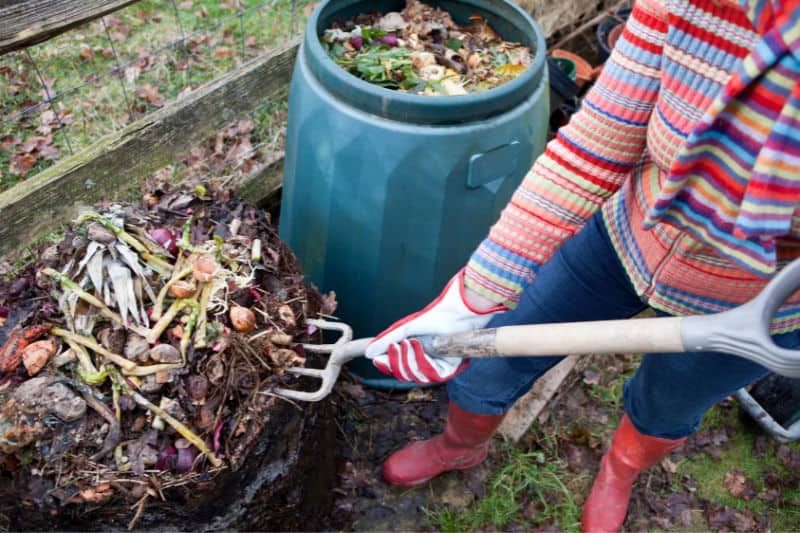A combination of substances called compost is used to fertilize plants and enhance soil’s physical, biological, and chemical qualities. Its main ingredients include decomposing plants, food scraps, recycling organic substances, and manure.
Unfortunately, early summer compost is sometimes discovered by gardeners to be a wet pile of partially decomposed material that appears to be worthless for months. Among the four essential elements you must keep an eye on is the moisture content of your compost.
Otherwise, everything may become out of balance. How do you determine the right moisture, and what should you do if the compost becomes too wet? Keep reading to learn all you have to know to cure your soggy compost.
Read: Should Compost Have Flies? (Answered)
Should Compost Be Wet?
Yes, compost requires moisture, but not drenching moisture. Instead, compost ought to be as wet as a sponge that has been wrung out. The procedure will slow down if it is too dry and stop altogether if it is too moist.
Composting microbes thrive at optimal moisture levels because they can move to other heap locations, transmit nutrients, and eliminate some waste products.
You should wait much longer to obtain your garden compost if the poor composting bacteria need more water to stay healthy and work efficiently.
How to Know If Compost is Too Wet?
If your compost is excessively wet, there are a few noticeable symptoms to look for. The first signs of wet compost are typically its texture and odor. Your compost might feel soggy if it is too moist.
In the worst scenario, it will also emit an offensive ammonia-like sweet, sticky smell. The composting process may be slowed down, stopped entirely, or interrupted if there is excessive moisture in the compost.
In addition, excessive water will obstruct air flow and make it challenging for microorganisms to function. Your compost will smell terrible due to the absence of oxygen because it has become anaerobic.
Water is necessary for the bacteria that cause composting to occur. Organic waste in the compost must be covered in a light coating of moisture for it to be digested.
Enzymes that they secrete into the water layer break down organic materials and let the organisms acquire nutrition. They can only do their job with wetness.
Additionally, worms scurrying away from the compost or a rotten egg odor are signs of wet compost. If the decomposition process takes less time, your compost may be too damp.
You can examine your compost with a moisture meter or perform a squeeze test in addition to looking for these indicators that it is excessively damp.
Moisture Meter
Compost moisture meters are devices you can purchase to test the amount of moisture in compost. Such meters have quite a long probe with a detector at the end. This is inserted deeply into the compost to evaluate the moisture content there.
You can tell if your compost is excessively moist or dry thanks to instruments for composting like this one.
Gardeners who love technology could already know they require a moisture meter. However, these items are optional for composting to be successful. Your hands serve as your body’s internal compost moisture meter.
Squeeze Test
You may now compare your compost’s consistency and water content to a wrung-out sponge. Grab a small amount of compost directly from the middle of your heap by digging into it.
Consider whether the compost feels almost as damp as a wrung-out sponge as you compress it for 1 or 2 seconds. When you press the compost, please pay attention to the amount of water that drips out of it, and when you release your grip, observe how the compost appears.
The moisture content is ideal if just a little water is emitted and the compost holds together while you open your palm. The compost is excessively wet if it feels squishy and clots in your closed fingers.

How Wet Should the Compost Be?
Compost should have a moisture level of between 40 and 60%. The majority of the time, your compost should remain this moist. A squeeze test is a useful tool because measuring this is a little challenging.
You should analyze the moisture content before selecting and combining the components for your compost. You will not likely need to take this measurement again once composting has started because you can see whether the proper moisture levels are all being retained.
Why is My Compost Too Wet?
Adding too many green compost ingredients is among the most frequent causes of overly wet compost. Organic waste high in nitrogen, such as grass cuttings or vegetable trimmings, is already quite wet.
As they begin to rot, they decompose swiftly and tend to collapse and condense. The air stops moving, as a result, preventing evaporation. The number of moisture rises.
Excess moisture seeps into the heap’s base and begins to smell when anaerobic decomposition begins. When compost conditions appear overly wet, the right material balance is generally the first crucial thing to consider.
When care is advised, it is always preferable to choose the side of precaution and use less green materials. Other causes of excessive moisture in your compost include:
- More water is being added than is necessary.
- There is insufficient airflow.
- You are mixing the components improperly.
- When using a container or tumbler, there needs to be better ventilation, poor drainage, and excessive rain exposure.
Signs That Waste is ‘Too Wet’ For Composting
Adding too many green compost ingredients is among the most frequent causes of overly wet compost. Organic waste high in nitrogen, such as lawn clippings or vegetable waste, is already quite wet.
As they begin to rot, they decompose swiftly and tend to collapse and condense. The air stops moving, as a result, preventing evaporation. The number of moisture rises.
Establishing the underlying problem is the first step when the compost needs to be damped. It might be an issue with the additions you are making. If not, your composting system can have an underlying issue.
How To Fix Wet or Soggy Compost?
Poor aeration, excessive moisture, and dysregulation between components rich in nitrogen and carbon typically contribute to a soggy compost pile. During the spring and fall, whenever carbon-rich materials are easily accessible, the ordinary backyard composter succeeds in turning kitchen and garden waste into compost.
However, throughout the winter, kitchen food wastes with a high moisture and nitrogen content are the main fresh additions to the compost. More carbon than nitrogen is required for good compost, but even fewer carbon-rich substances are available during the winter.
The accessible carbon sources, including twigs and dried grass clippings, might clump together in the absence of regular turning of the compost, further limiting ventilation and delaying the composting process.
Below are ways to fix wet compost:
Cover the Compost if Open
Compost piles need to be wet but not drenched. Your compost heap must be covered, particularly before the springtime rains, unless you reside in an extremely dry environment.
Provide aeration if the compost is situated on the ground. Runoff can be diverted from the compost heap by digging a short trench.
Include Fine Carbon Material That Decomposes on Time
Adding carbon-rich materials can reduce the excess water in the compost and help it achieve the proper carbon/nitrogen ratio for composting. Use materials that are one-third nitrogen and two-thirds carbon as a general rule of thumb.
However, the decay of bulky carbon compounds takes longer. Select finer, carbon-rich components that will decompose more quickly to revive a soggy compost for usage in the coming month or two.
Fork or Turn the Compost
After adding fine, dry materials high in carbon to the compost, disintegrate any significant lumps of tangled material using a pitchfork or shovel. Since matting limits aeration and delays composting, this is crucial in any compost heap.
This will be simple if you own a composter with a tumbler design. Every time you add materials, give the composter a quick spin. This is only possible if your composter is placed on open ground.
The composting material can easily be mixed with absorbent material if you remove the composter and allow it to spill onto a tarp. This can be loaded into a barrow and spread throughout the garden area, where it can begin to relax.
Include a Nitrogen Activator
Finally, by incorporating a “hot” source of quickly accessible nitrogen, you can “reboot” the composting process. Although not necessary, this will expedite the procedure. Take some completed compost from the bottom of your stationery compost pile and include it at the top.
Gardeners are eager to get completed compost in the early spring. Freshly planted plants can use the finished compost immediately because it is moist, flaky, and spreads quickly.
Conclusion
Although wet compost is disgusting, your composting trip is not over yet. You can return things to normal with only a small bit of work.
If your compost is excessively wet, add additional dry components, flip more frequently, and increase drainage. Slimy compost can usually be salvaged as well.






